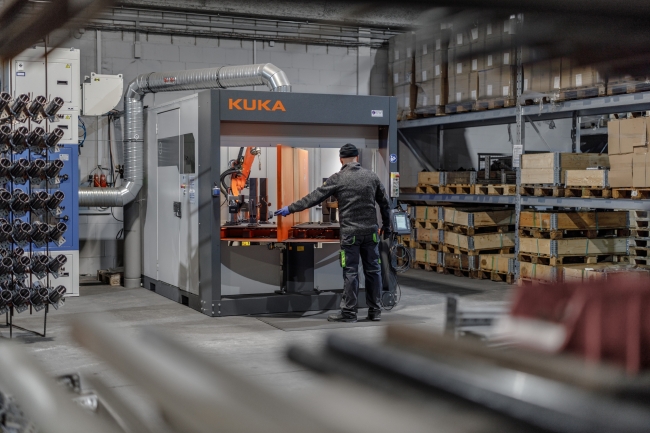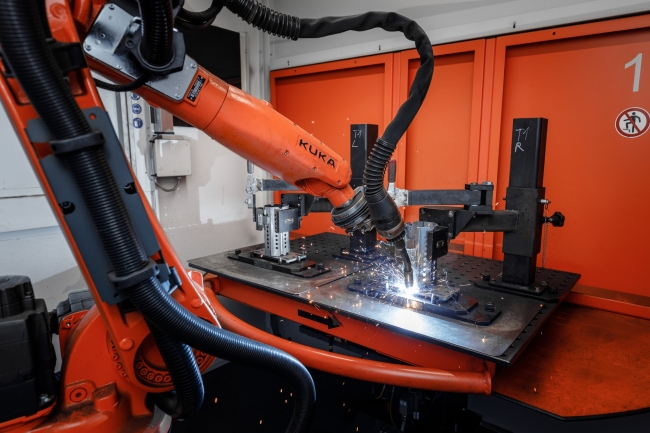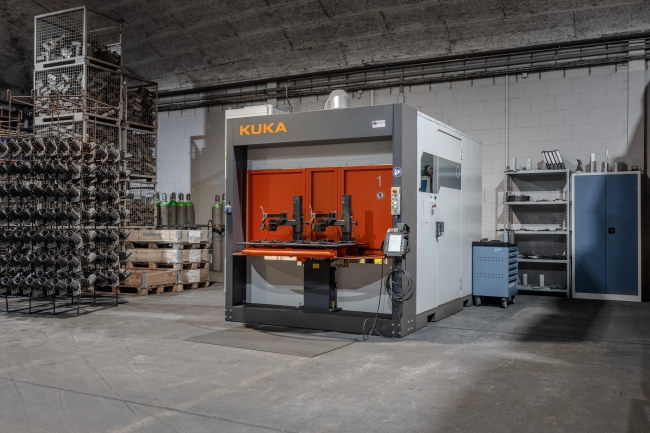6 minute read • published in partnership with KUKA
Case Study: How a KUKA robot helped an SME galvanizing plant expand its portfolio
Few galvanizing plants also weld steel parts. Their core competence is hot-dip or centrifugal galvanizing to protect steel parts from corrosion. But in Sulz am Neckar in Germany, Verzinkerei Sulz GmbH offers a lot more than that with its KUKA welding robot and cell.
No one who sees the KR CYBERTECH nano at work would think this is unusual. With ease and precision, the robot uses a welding device to join an octagonal prism to a compact steel plate, completing two welding processes in a mere 90 seconds. An employee removes the finished products and replaces them with two new ones. “The quality of the weld seams is outstanding,” said Bernd D. Euschen, Managing Director of Verzinkerei Sulz, who is delighted with the robot-based solution featuring the KR CYBERTECH nano welding robot.
Long distances provide the impetus for automated production
The KR CYBERTECH nano is used on welding assemblies characterized by their versatility and resilience. These adapters are designed for welded connection to steel beams, weld-on plates and other connection points. They help create suspensions, cross members and other structures in buildings and on construction sites. In the past, Euschen explained, the welds on these assemblies were of varying quality. Because of changes in subcontractors, some of the welding work was done by hand and some with robots.

Picture: KUKA
The benefit: consistent level of quality, less transportation
To do this, the customer had these components trucked to Eastern Europe for welding, and then transported the welded assemblies to Verzinkerei Sulz in the Black Forest for galvanizing, fabrication and shipping. “That meant our customer had to send 40 tons out on the road twice a week,” Euschen explained. This was not optimal, and the customer was looking for a new service provider for this task, “preferably close by.” That’s when Euschen and his team came up with an idea: “Why don’t we do it here in Sulz am Neckar?”
Automated welding: a novelty for a traditional company
Euschen admits that this approach was unusual for his industry: “We certainly don’t know of any other galvanizing plant in Germany that has a welding robot.” Nevertheless, the potential order sounded interesting, and the opportunity to cut out thousands of transportation kilometers and a whole lot of CO2 in the future sounded very appealing. So Euschen and his team decided to help out a good customer and to be a company that focuses on resource-efficient manufacturing. And just like that, Verzinkerei Sulz, with nearly five decades of galvanizing experience, took on a new challenge.

Picture: KUKA
Integrating a welding robot into production
It was clear from the outset that this job needed to be automated because assigning it to one of the galvanizing plant’s 65 employees was out of the question. The company had no welders, and none were to be found in the entire region. But Bernd D. Euschen knew that robots were capable of laser welding, friction stir welding and arc welding, among other things, and were getting better at it all the time. To stay true to the principle of short distances, Euschen started looking for an expert integrator in his area. That’s how he met Christoph Welle, the Managing Director of KIWI-Automations GmbH in Oberkirch, Baden-Württemberg, which emerged from a design office in 2006 and has been a KUKA system partner since 2016. Christoph Welle and his team were delighted to get involved right away.
Automated welding of sheet metal, stainless steel and other products
“The job was to weld the various parts of an entire product family at a relatively high speed with versatility and consistent quality,” recalled Christoph Welle. “We never considered welding up to 10,000 components per month by hand. The robot achieved consistent quality, and interchangeable fixtures on the machines accomplished the versatility. We designed these in a kit-like form for quick fixture conversion to handle different parts of product families with easy selection of various programs. This allows you to work on a new product after only a short setup time.”
Automated welding for SMEs
Well networked in the SME sector and for Industry 4.0
Bernd D. Euschen added, “We needed a compact system. We wanted to take our first steps toward robotic welding, and thereby learn the ropes and gain expertise. Safety also was important.” The KUKA team responsible for the job had expertise in welding application, which proved very helpful. The system integrator collaborates with many companies in the sheet metal processing industry and knows the industry inside out, which also proved beneficial. These advantages helped yield the right solution for Verzinkerei Sulz and its customer.
The smallest welding cell is just the right size
Verzinkerei Sulz chose a compact cell that measures 3,980 mm long, 2,365 mm wide and 2,445 mm high, and offers plenty of power despite its small footprint. The cell uses a KR CYBERTECH nano, a slim robot with an extremely small interference radius, the smallest in-line wrist in its robot class, high repeatability and great versatility. For the welding system, Euschen and Welle chose the TPS 400i from Fronius, which is as reliable as it is communicative. Euschen is pleased with the manual rotary table as a positioner, which accommodates the welding fixtures, and the KR C4 small size robot controller. Cycle times and the way the weld seams are set were checked in advance using KUKA.Sim software. Then Euschen looked for and found someone on his team to load and unload the cell, hired a new employee with programming skills, and they were off.

Picture: KUKA
Enhancing welding robots with digital products
The KUKA.ArcTech software enhances the robot system with intuitive commands, structured menus and practical status keys that enable simple arc welding with high precision. And with success: “A welding process takes less than a minute,” said Bernd D. Euschen with delight. Depending on the type of steel base plates involved, Euschen estimates they galvanize 5,000 to 10,000 components each month. “Annually,” he revealed, “we are close to six figures.”
After nine months, the overall result is correspondingly positive: “We calculated that it would take two-and-a-half years to achieve a return on our investment, but we are confident that we already will have broken even after one-and-a-half to two years. After all, the fact that we now also have welding capabilities has helped us get other galvanizing jobs. We’ve been able to strengthen our core processes.”
Perfect weld seams for a manageable investment
During a skilled-worker shortage, Euschen believes that automation is the only option for many small and medium-sized companies, and encourages other entrepreneurs to consider it. “Let me be very clear on this: Not only are the investment costs manageable, but the opportunity to use that investment to take your first steps, gain expertise and land your first good orders from customers is significant,” he said. Christoph Welle also is pleased: “For us as a system integrator, this is a very good pilot project to show other companies how easily they can get started with automation. We can show them there is no need to hesitate and that even small companies can grow into it slowly.”
Welle went on to say that “both companies found KUKA to be a reliable, competent partner in the areas of automation and welding expertise. The KUKA team assisted us wonderfully well in terms of welding programming and welding optimization.” This was the only way to ensure that Verzinkerei Sulz looked as if it always had been in the welding business.

Picture: KUKA
Other ideas for automation and digitalization
Verzinkerei Sulz employees were happy to support the decision to integrate a welding robot. “We hired new employees for the welding cell because we knew we had to build up expertise,” Euschen explained. “Overall, our employees take a highly positive interest in the automation solution. They can see that we are breaking new ground and securing the future of the facility.” Meanwhile, the same major customer whose extensive jobs prompted acquisition of the welding robot promises that new orders will follow. Other potential customers also have come knocking. Bernd D. Euschen and his team, together with KIWI-Automations, already are busy planning other automation solutions with KUKA.
